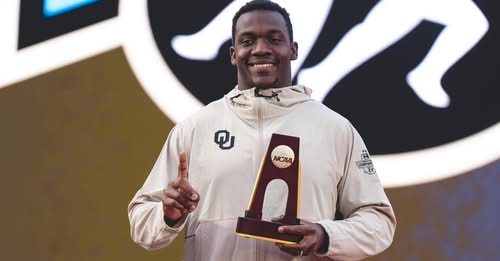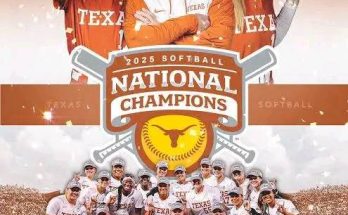The University of Oklahoma Men’s Track & Field team brought its 2025 outdoor campaign to an emphatic close, turning heads and making history at the NCAA Outdoor Championships. It was a season finale that not only showcased the remarkable depth and talent of the program but also cemented the Sooners’ status as a force to be reckoned with on the national stage. Multiple individual national titles and a sixth-place team finish highlighted an extraordinary performance in Eugene, Oregon, as athletes in crimson and cream took center stage and delivered when it mattered most.
It all came together across four unforgettable days of competition at Hayward Field, where Oklahoma’s stars rose to the occasion and embraced the biggest stage in collegiate track and field. The Sooners arrived with high expectations, backed by a strong regular season that saw them dominate conference meets, rise steadily in the rankings, and gain valuable experience in elite invitationals. But even those expectations were eclipsed by the sheer brilliance and resilience the team demonstrated under championship pressure.
At the forefront of Oklahoma’s success was senior sprinter Dorian Hamilton, whose season-long consistency and explosive acceleration culminated in a breathtaking victory in the 200-meter dash. Hamilton, who had been narrowly edged out in the indoor championships earlier in the year, finally got his moment of redemption. Clocking in at 19.97 seconds, he edged out a stacked field that included top sprinters from LSU, Florida, and Texas A&M. The moment he crossed the finish line, he erupted with emotion, dropping to his knees in disbelief as his teammates mobbed him in celebration. It was a title well-earned, and one that spoke volumes about his work ethic, his preparation, and his unshakeable belief in himself.
But Hamilton wasn’t done. Just days later, he anchored the Sooners’ 4×100 meter relay team to another title, this time teaming up with freshman phenom Chris Tate, junior Marlon Evans, and veteran speedster Reggie Norris. The quartet blazed their way to a time of 38.31 seconds, outlasting a fierce charge from USC and Tennessee. The chemistry between the runners was undeniable, honed through months of training and trust. When Norris handed the baton to Hamilton on the final exchange, the result felt inevitable. With every stride, the stadium roared louder, and as Hamilton crossed the line in first, it marked Oklahoma’s first NCAA relay championship in nearly two decades.
Meanwhile, in the field events, sophomore high jumper Tyler Bronson made his own piece of history. Entering the competition as a dark horse, Bronson methodically cleared bar after bar, eventually topping out at 2.31 meters to secure the national title. It was a performance defined by poise and precision, with Bronson maintaining a steely focus through each attempt. His winning leap was not only a personal best but also a new school record, eclipsing a mark that had stood since 1996. For Bronson, a former walk-on who had flown under the radar for much of his career, the win was a testament to patience, perseverance, and the power of belief.
Oklahoma’s scoring continued in the distance events, where junior standout Elijah Herrera battled through grueling heat to place third in the 5,000 meters. Herrera’s time of 13:22.14 was his best of the season and good enough to keep Oklahoma firmly in the hunt for a top-10 team finish. He followed up that performance with a gutsy sixth-place showing in the 10,000 meters just two days later, proving himself as one of the most versatile and dependable distance runners in the country.
Points also came from the throws, where senior discus thrower Malik Gordon earned All-American honors with a fourth-place finish. His throw of 62.44 meters not only earned vital points for the Sooners but also capped a stellar career that saw him develop from a promising freshman into one of the most respected throwers in the NCAA. Gordon’s leadership and mentorship of the younger athletes have been an underrated but vital part of the team’s culture, and his contributions off the field were just as impactful as those on it.
In total, Oklahoma amassed 41 points—good enough for a sixth-place team finish, their highest placement since the mid-2000s and a statement of intent to the rest of the collegiate track & field world. Only traditional powerhouses like Florida, Arkansas, and Oregon finished ahead, but the Sooners held their own and in many ways outperformed expectations, especially considering the youth and relative inexperience of some of their key contributors.
Head Coach Tim Langford, now in his seventh year at the helm, was visibly emotional following the conclusion of the championships. Speaking to media on the infield, he praised his athletes for their resilience, unity, and competitive spirit. “This group of guys believed in the process, and they trusted one another,” Langford said. “We’ve built something special here, and this weekend was the result of years of hard work. These titles belong to every member of this program—past, present, and future.”
Langford also credited his assistant coaching staff, singling out sprint coach Tony Reid and jumps coach Marcus Wilkins for their exceptional work in preparing the athletes for championship competition. Their ability to fine-tune technical details while keeping the athletes mentally sharp proved critical in such a high-stakes environment.
Beyond the medals and finishes, what stood out most was the spirit of the Oklahoma team. Every event was met with raucous support from teammates, who filled the stands with chants and cheers, creating an energy that seemed to elevate each performance. There was a sense of brotherhood and shared purpose, a rare and powerful dynamic that often separates good teams from great ones.
The Sooners’ presence was felt throughout the meet, not just in wins and podiums, but in the way they competed—fearlessly, passionately, and with pride. Whether it was a freshman like Chris Tate holding his own on the big stage, or a senior like Malik Gordon giving everything in his final collegiate throw, the collective effort spoke volumes about the culture Coach Langford has cultivated.
And while this season has now come to a close, the future appears even brighter for Oklahoma Track & Field. With several top recruits set to join the program in the fall and key contributors like Bronson, Tate, and Herrera expected to return, the Sooners are poised to make another deep run next year. Hamilton and Gordon will graduate with accolades and legacy intact, but they leave behind a program that is more confident and competitive than ever.
Perhaps what this season truly represented was a turning point—a moment when the Sooners stopped being a team full of potential and started being a team of proven champions. The sixth-place finish wasn’t just a number on a leaderboard; it was a message to the rest of the NCAA that Oklahoma Track & Field is not just showing up—they’re coming to win.
As the athletes returned home to Norman, they were greeted with fanfare and celebration, the university community embracing their accomplishments with pride. There were banners hung in the athletic complex, social media tributes from Sooner legends, and a growing sense that this team had not only represented the school with honor but had etched its name into the rich tapestry of Oklahoma athletics history.
With the sun now setting on the 2025 outdoor season, the memories of Hayward Field still fresh in their minds, the Sooners can take a well-earned moment to reflect. They fought with heart, they triumphed with class, and they ended their campaign not just as competitors, but as champions. From Eugene to Norman, the message is loud and clear—OU Men’s Track & Field has arrived, and they’re here to stay.



